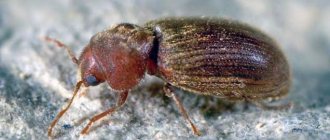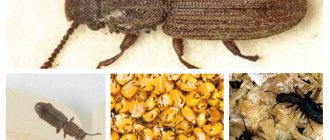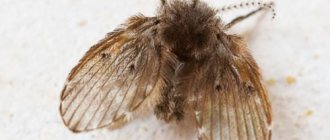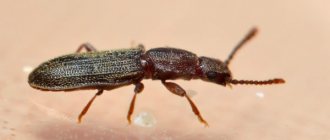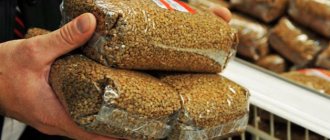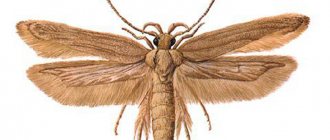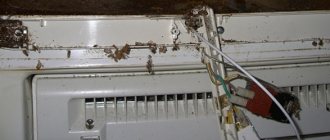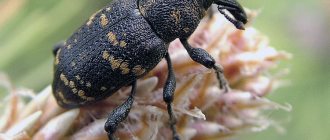Is it possible to eat grains and flour infested with beetles?
If bugs appear in cereals, how to get rid of them is an important issue for preserving other products.
| Name | Habitat Features | Where are they found? |
| Bread grinder | Able to fly, not afraid of light, found between window frames. Penetrates with animal feed | • Bakery products. • Medicinal herbs. • Tea. • Coffee. • Cocoa. • Cereal mixtures. • Book bindings |
| Flour beetle, beetle | The pest is highly prolific. The eggs are microscopic in size and easily pass through the sieve opening. | • Flour.• Starch.• Rolled oats.• Semolina.• Bran.• Dried fruits.• Rice.• Buckwheat |
| Red mukoed | Comes with low quality animal feed | • Cereals.• Grains.• Expired flour |
| food moth | The reason why the insect appears is improper food storage, ventilation, or an open window. Active mainly at night | • Buckwheat.• Hercules.• Semolina.• Pasta.• Rice.• Flour.• Tea.• Dried fruits |
| Rice weevil | It is highly fertile, reproduces quickly, and flies well. It has a powerful mouthparts, thanks to which it is able to gnaw through grain. The optimal temperature for reproduction is between 26-30 degrees | • Rice.• Buckwheat.• Wheat.• Barley |
| Bean grain | Completely eats up beans and cereals | • Beans.• Beans.• Peas.• Lentils.• Soybeans.• Chickpeas |
Food should not be consumed together with insects. Before using cereals, you need to get rid of pests.
However, even careful processing will not be able to remove larvae, scales, and waste products of beetles. They pose no danger to a healthy adult.
Before using cereals you need to get rid of pests
It’s a different matter when it comes to children and people with weakened immune systems. In these cases, the use of such products can cause a severe allergic reaction or cause intoxication of the human body, which will lead to disruption of the functioning of the gastrointestinal tract and an increase in body temperature.
Types of insects that may be in cereals
For a good housewife, there is nothing worse than discovering bugs in purchased cereals. It's especially frustrating when there are a lot of food supplies. Why do bugs appear in cereals, despite daily wet cleaning and keeping the cabinets clean?
Most often, the reason lies in violation of sanitary control at the factory. Improper storage and neglect of the necessary heat treatment of products are factors in the appearance of beetles in cereals. A humid environment promotes their reproduction.
In order to start taking action, you need to know what bugs are found in cereals. The names of some pests sound funny to the outside ear: flour beetle, Suriname flour beetle, pretend beetle, rice weevil, Moorish booger and dust louse. But the appearance of such insects in cereals is a real disaster in the house.
Flour beetle. It prefers a substrate with elevated temperature and humidity, and is found during storage of rice, oats, wheat, barley and soybeans. In addition to grain, it eats bread products and flour, preferably coarsely ground. If the damage is severe, the flour becomes lumpy and unsuitable for food.
In the photo there is a flour beetle
The pretend beetle. It got its name from its ability to pretend to be dead. At the moment of danger, he tucks his antennae and paws, falling from the object on which he was crawling. There are about 20 species of such beetles. A pretend thief, a robber, a robber, a pretend little one - all these insects are similar to each other.
In the photo there is a pretend beetle
Rice weevil. Despite the harmless name, it is an extremely dangerous and harmful creature. At home you can find it in cupboards in jars of cereals. It destroys not only rice, but also stocks of other cereals and food products. It does not neglect pearl barley, dry flour products, it is found in corn, beans, crackers, and wheat grains.
Pictured is a rice weevil
Suriname mucoed. Another flour beetle, which also spoils dried fruits, feeds on dry meat and pharmaceutical medicinal plants. The insect easily penetrates loosely closed boxes, bags and other containers with bulk products. The photo clearly shows the bugs in the rump. Soon it will be spoiled by their excrement.
In the photo there is a Surinamese mucoed
Moorish booger. Africa is considered its homeland and is distributed everywhere. Damages cereals, confectionery, cereals. But he prefers to eat flour. Both larvae and adult beetles are capable of chewing through bags, sieves, paper and cardboard packaging.
Pictured is a Moorish booger
Dust louse. Damages stocks of flour, oatmeal and other bulk products, clogging them with waste products. A favorite delicacy is cereals that have been preserved for a long time, as well as anything that begins to rot or mold.
The photo shows a dusty louse
Why did worms appear?
If the moth is not brought in from outside, figure out what reasons caused its appearance in your food supplies:
- Expired shelf life. Don't forget to look at the manufacturing date on the packs. Do not buy “tons” of cereal in anticipation of a hungry year. Throw away expired cereals without regret.
- Violated storage conditions. Do not create a tropical climate in the kitchen with high temperature, humidity and stuffiness: moths will perceive this as a signal to reproduce. Ventilate your galley more often, and send bulk provisions to the balcony in winter - for prevention.
- Wrong container. The ideal option is a glass container with a tight-fitting or airtight lid. The less air enters the jar, the longer the shelf life of the product.
If the larvae of the cereal moth have already penetrated your food, radical advisers demand... throw it away, since even by removing the living creatures, you are unlikely to clear your supplies of its microscopic excrement
We suggest you familiarize yourself with How to disassemble an Electrolux vacuum cleaner video
Where do bugs in cereals and larvae come from?
In most cases, the insect or its larva gets in with poor quality cereals purchased by weight. However, it is not uncommon for beetle eggs to be found in vacuum packaging, if we are talking about unscrupulous manufacturers who violate the sanitary regime for storing cereals in factories and warehouses.
Be sure to read:
Ants at home: how to get rid of ants at home using folk and chemical means forever
Infection can occur in recently purchased cereals due to improper proximity, when prunes, pasta, flour, tea, coffee, and spices are stored nearby.
Tips from experienced housewives
The centuries-old fight against kitchen “evil spirits” has enriched folk experience with several effective recipes to block the path of voracious parasites:
- you need to put an aluminum spoon or a piece of foil into the flour and cereal;
- use fabric bags for bulk provisions, previously soaked in a strong solution of table salt;
- some housewives are sure that any metal storage container is an excellent preventive measure against worms;
- Many people recommend adding cloves of garlic to cereals.
Most likely, the “invaders” are entering your kitchen along with groceries brought from the store. Inspecting purchased flour and cereals is your primary task.
Prevention
If there are bugs in the cereal, getting rid of them is not so difficult, but it will require some time and effort. In addition, you will have to say goodbye to at least part of the product affected by insects. The best way to deal with parasites is not to give them a single chance to “populate”. Keep your cupboards and kitchen counter tidy, and store food supplies in airtight containers. Check regularly for cereal bugs. Getting rid of the problem at an early stage is much easier and less expensive. The more supplies you have at home, the more often you need to audit.
If you don’t want to think about where the bugs got into the flour and what to do with them, don’t neglect prevention. One of the means to prevent the appearance of harmful insects is the use of strong odors. Bay leaves, garlic and cloves on the shelves will become quite a serious barrier for parasites. Bugs will not appear in flour if it is stored in a glass or plastic container with an airtight lid. The main thing is that the product is clean from the beginning.
We have already mentioned why bugs most often appear in cereals. What can you do to eliminate the possibility of bringing home low-quality food? Firstly, try not to purchase dubious goods on the cheap. Secondly, new products should be subjected to heat treatment. Staying in the freezer will completely kill the bugs in flour and cereals. Science has not yet figured out how to get rid of possible larvae in another way. Note that parasites can also live in tea, cocoa, pasta and dried fruits. Finally, let us express our hope that your peace will never be disturbed by bugs in your cereal. You already know how to get rid of them in the kitchen, but not all knowledge needs practical testing. You can get more detailed information on important everyday issues on the website of our company in Moscow.
Source
The best ways to deal with kitchen bugs in bulk products
The most effective of all known methods is the use of an aerosol product called Dichlorvos. After using this product, not a single bug will remain alive.
The method is not the safest to use, but it will definitely help completely solve the problem. The product disappears from the room within several days. You cannot be indoors at this time. It is necessary to think about the place of residence for this period of time even before the start of cleaning.
How to remove beetles:
- Carry out a thorough inspection of those things where insects may be located, and remove these items from the room.
- Throw out the entire stock of cereals, wash the jar in which they were located, and all the dishes in the kitchen.
- Wipe the baseboard, floor, every cabinet.
- Wear protective equipment and treat the room with Dichlorvos. It is important to treat every hard-to-reach crack, since these are the places where insects can be found.
- After ventilation, all surfaces must be thoroughly washed.
The flour must be sifted using a fine sieve. This will make it possible to get rid of larvae and eggs.
When the product is sifted, it is calcined in the oven for 30 minutes. For flour, 50 degrees is enough.
We suggest you read: Worms in cereals, can you eat cereals?
After these steps, the flour will become suitable for consumption.
Bugs in flour
There are several methods to resolve the issue:
- Using the oven. The procedure takes 30 minutes. Semolina and flour should not be exposed to temperatures above 50 degrees. For other types of cereals, this figure can reach from 110 to 200 degrees.
- Exposure to ultraviolet radiation. The products are evenly laid out on a clean, flat surface and left for 2-3 hours. The beetles will leave the food if they cannot withstand exposure to ultraviolet rays.
- Exposure to low temperatures. The cereal is placed in the freezer for a day. A balcony is suitable for these purposes. You can take food outside if it is a private house when the air temperature is at least 15 degrees below zero.
Be sure to read:
How to fight moths in an apartment, where they come from, folk remedies and chemistry
Pests often hide in furniture and other rooms. Therefore, the entire apartment, especially the kitchen, must be treated with additional methods.
Boric acid has a poisonous effect. Individuals absorb the poison and bring it with them to the nest, as a result of which the entire colony of pests dies.
To make bait, borax is mixed with sugar and flour. Semolina, egg, honey can be added, after which the bait is laid out on sheets of paper and placed in the place of the greatest concentration of beetles.
If you need to prepare a dish urgently and the grains are spoiled, use salted water. The cereal soaked in it will remain at the bottom, and light bugs will float to the surface. After this, it is recommended to heat the product in the oven and sift.
Water will help not only when manipulating directly with products, but also during the cleaning process. To do this, all furniture must be washed with water and vinegar. Per liter of liquid you will need 1 tablespoon of the product.
The best option is to treat shelves and corners with boiling water. But not every surface can withstand high temperatures.
In addition to traditional methods, there are folk methods for solving the problem:
- Fragrant herbs. Bugs cannot tolerate plants with a strong odor. To do this, small bags containing wormwood, chamomile, and lavender are placed in the cabinet, especially in the corners. You can also use garlic, cloves, and nutmeg.
- Sunflower oil. After heat treatment, you can pour a little sunflower oil into small caps. This will help trap insects. Then you just need to pour out the oil.
- Pheromone lures. These control agents can be purchased in specialized stores. The bait attracts the surviving individuals.
Be sure to read:
Dust mites: how to get rid of them at home, why they are dangerous, elimination in 4 steps
We invite you to read How to clean gold to make it shine: care at home
Where is the best place to store cereals:
- Glassware. The optimal container is a glass container with tight lids. It is advisable to place the containers on the top shelves of cabinets, where there is sufficient light.
- Fridge. Due to the low temperature conditions, adults will not be able to reproduce.
Is it possible to eat this cereal?
If you find cereal that has bugs in it, don’t even think about whether it can be used, but throw it away immediately. Contaminated products contain the remains of chitinous shells, excrement, and various forms of insect development. Bacteria and fungi settle in such cereals and find an environment for development.
The remains of shells covered with bristles are not digested in the digestive tract of humans and can cause irritation and inflammation of the stomach. Guanine and scleroproteins that are part of tick waste are not absorbed by any organism. In grain affected by pests, uric acid is formed in large quantities, which can cause a number of diseases in humans.
If there are bugs in rice, buckwheat, oatmeal or any other cereal, do not use it. Damage to the body is not detected immediately after eating spoiled cereals. The process of undermining is hidden, cumulative and gradual. As a result of such nutrition, amino acid metabolism in the body is disrupted, the number of red blood cells and hemoglobin in the blood decreases, which leads to lethargy, weakness, and sometimes more serious consequences. Therefore, if there are bugs in the cereal, then it is better to get rid of it than to have health problems. The same applies to flour.
Theoretically, flour containing bugs can be used, but is it worth it? No matter how you sift it, there will still be excrement in it. For example, flour damaged by the Moorish booger darkens, acquires an unpleasant odor and becomes unsuitable for use in cooking. If you make dough from such flour, it will not rise well and the bread will turn out low and soggy.
Getting rid of bugs and worms
- If the larvae of cereal moths have already penetrated into your food, radical advisers demand... to throw it away, since even by removing the living creatures, you are unlikely to clear your supplies of their microscopic excrement.
- If you feel bad about throwing it away, you can try calcining it and sifting it. Pass semolina and flour through a sieve. Cereals with more tangible grains should be placed in an oven heated to 120 degrees for a quarter of an hour. After the cereal has cooled, it is sifted through a colander with fine holes. Such measures will also allow you to get rid of flour moths, which prefer to lay their larvae in flour.
- Fundamental “disinfection” also includes the treatment of furniture: cabinets must be thoroughly scrubbed with vinegar (outside and inside). Wash the backs of wall cabinets and all kitchen utensils and dishes.
- Throw away old plastic and paper bags that provide both food and shelter for kitchen pests.
- Keep in mind that grain moths can settle in different nooks and crannies of your apartment, so don’t be lazy, go over all the furniture, lamps and cornices with a damp cloth.
- You are given one day for general cleaning - during this time the insects will not be able to gain a foothold in the new bridgehead.
From now on, maintain exemplary order in the kitchen, regularly getting rid of trash and not forgetting to “audit” your storage areas.
Bugs in the kitchen: varieties
Before we move on to discussing the question of how to get rid of cereal bugs in the kitchen, let's take a closer look at the “opponents”. Insects, whose vital needs so unfortunately coincided with our interests, belong to one of the following varieties:
- flour beetles;
- bread grinders;
- food moth;
- red mucoeds.
The most widespread parasites are the first type. These are small brown individuals, the length of which does not exceed 4 mm. A small flour bug usually gets into the home along with a bag of starch or some kind of powder mixture. Once in the closet, the hruschaks immediately begin to look for new habitats. If there is a loosely closed container with other bulk products nearby, the flour beetle will definitely “master” it. Cereals, rice, dried fruits and buckwheat are also at risk, although these pests are much less interested in them.
Naturally, the longer the little black bugs in the kitchen go unnoticed, the more food will be destroyed. Khrushchaki reproduce very quickly, laying their eggs in a variety of places. Newborn larvae immediately begin to invade nearby “deposits”. We will tell you below how to deal with bugs in cereals and flour.
Other types of harmful insects are much less common. The mole is easy to spot. Its adults can reach 10 cm in length. Outwardly, these cereal beetles resemble silver butterflies. Such “guests” enter the apartment through ventilation and windows. The object of their attention is products stored in the public domain.
Bread grinders and flour eaters prefer to settle in industrial enterprises. When it comes to these insects, the problem of how to get rid of insects in cereals concerns more the personnel of the above organizations. However, unfortunately, ordinary citizens also have to deal with them. Grinders are small flying white bugs in the kitchen that can measure up to 3mm. Their target is usually bread and flour products: biscuits, cookies, etc. In this regard, they pose the greatest danger to bakeries and flour mills. Grinders enter residential buildings through bags of food or animal feed. In addition to bakery products, these food bugs happily consume coffee, tea, dry plants, animal feed and even book bindings. So if they happen to be your guest, it's not just your kitchen cabinets that may need a major cleaning.
How to get rid of flour eater is also a relevant question mainly for owners of food enterprises. These miniature red insects can only feed on rotten grain or flour. If the humidity of the product is below 15%, it is not in danger. How to get rid of mucoed in an apartment? Very simple. You just need to throw away substandard food in a timely manner. The main danger lies in cheap animal feed. If you take the choice of food for your pet with sufficient responsibility, then these small bugs will never appear in the kitchen. If trouble happens, you have no choice but to act according to the scheme described below.
Prevention of recurrence
There are certain preventive measures to prevent the appearance of unpleasant insects:
- Purchase products as needed. Long-term storage contributes to the appearance of pests and loss of taste.
- Use a dry, cool room to store cereals, with good ventilation.
- Storage of bulk products in glass containers with tight lids and perforated plastic bags. Linen bags and metal containers are also suitable for this purpose.
- In winter, store cereals on the balcony or loggia.
- Compliance with product expiration dates. For example, millet cereals are stored for no more than 3 months, buckwheat and rice - up to 6 months, flour and dried fruits - 1 year.
There are no ideal ways to remove bugs. You cannot be sure of the integrity of the cereal manufacturer, even if vacuum packaging is used.
Therefore, the key to preventing the appearance of beetles is to regularly clean the kitchen area using disinfectants, inspect food supplies, and adhere to storage deadlines.
Oh moth
Food moths can appear even in the kitchen where cleanliness is maintained. Its larvae attack cereals, dried fruits and other bulk products. The moth reproduces quickly, making it difficult to remove, but it is still possible.
Food moths are small butterflies of a discreet color: brownish with stripes or gray with splashes. Its length is up to 1 cm. The food moth flies quickly, randomly changing direction, so it is difficult to swat it. In addition, when detected, the butterfly tries to quickly hide in a secluded place. Mostly, adult moths are active at night, so it is difficult to notice them right away - this usually happens when a lot of moths have already bred.
Food moths live from a couple of days to several weeks, and during this time they manage to leave many offspring, which infect food and cause discomfort to the residents of the house. Moths lay eggs in almost all bulk products (cereals, flour, pasta, nuts, dried fruits and even tea). White larvae - worms - soon emerge from the eggs; in the kitchen they can be found on walls and furniture. They spoil food, gnaw it, contaminate it with excrement and skins that remain after degeneration into adult insects, so such products can no longer be eaten.
Kitchen moths live well in conditions of lack of air, so they can multiply in tightly closed jars. By the way, moths can chew through plastic bags, so they can move from one closed package to another. So it is better to store cereals in glass or tin jars with tightly screwed lids so that moths cannot move onto other foods and breed throughout the kitchen.
Types of moths
There are several types of food moths:
- barn - eats nuts;
- flour - starts in flour;
- grain - affects cereals;
- moth dry - eats mushrooms and dried fruits;
- potato - feeds on potatoes.
Signs of moths in the kitchen:
- cocoons and cobwebs in cereals and other products;
- flying butterflies;
- crawling white worms.
By the way, adult flying moths do not eat anything - only the larvae destroy food. It is important to remember that you should not eat foods contaminated with moths - this can cause allergic reactions and even poisoning.

